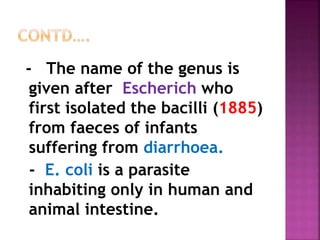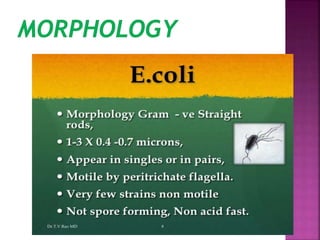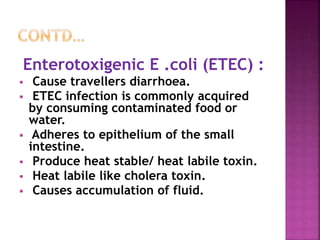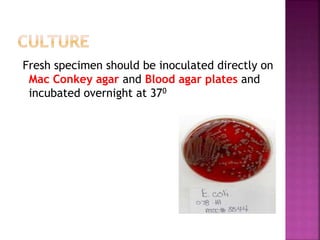Escherichia coli
- 3. - The name of the genus is given after Escherich who first isolated the bacilli (1885) from faeces of infants suffering from diarrhoea. - E. coli is a parasite inhabiting only in human and animal intestine.
- 6. E. coli causing diarrhoeal diseases are divisible into five groups . They produce diarrhoea with different pathogenic mechanism.
- 10. Enterotoxigenic E .coli (ETEC) : Cause travellers diarrhoea. ETEC infection is commonly acquired by consuming contaminated food or water. Adheres to epithelium of the small intestine. Produce heat stable/ heat labile toxin. Heat labile like cholera toxin. Causes accumulation of fluid.
- 16. - E. coli forms a part of normal intestinal flora of man and animals. - E. coli is excreted in faeces of man and animals in very large numbers and contaminate soil and water . Infection acquired by consuming contaminated food or water . - Some strains of E. coli produce enterotoxin, hemolysin and verocytotoxin.
- 18. Enterotoxigenic strains of E. coli (ETEC) Produce two different toxins. . . Heat labile toxin (LT). . Heat stable toxin (ST). A. Heat labile toxin: - It is a heat labile protein. - It is destroyed by heating at 650 C for 30 min. - It is composed of A sub unit and 5 identical B sub unit.
- 21. B. Heat stable toxin: - ST is a low molecular weight polypeptide and poorly immunogenic. - Two major classes of E. coli ST are known. ST-I and ST-II. - ST-I is not destroyed by heating at 1000 C for 30 min.
- 22. - It activates guanylate cyclase causing the increased production of cyclic guanosine mono phosphate (cGMP) and subsequent hypersecretion. - ST-II is produced by some strains of E. coli . - The mechanism of action of ST-II is not known but it appears not to act via cAMP or cGMP - The enterotoxin alone is not sufficient to cause diarrhoea.
- 23. Haemolysin: - Many strains of E. coli produce a haemolysin which can bring about lysis of RBCs of some species. - In experimental animals, hemolytic strains found to be more virulent than non hemolytic ones. - It is likely that hemolytic strains of E. coli obtain iron from lysed erythrocytes of the host.
- 24. Verocytotoxin : - E. coli produces cytotoxin identical to the Shiga toxin (Stx) produced by S. dysentriae type I. - The best known of these strains is 0157:H7. - This causes HUS (hemolytic Uremic Syndrome) and food borne illness.
- 25. - The verocytotoxin is cytotoxic to Vero cells (African Green Monkey Kidney cell), hence the term Verocytotoxin. - It also reacts with and is neutralized by the antibody against Shiga toxin.
- 26. It can cause four main types of clinical syndrome. . Urinary tract infection . Diarrhoea and dysentry. . Pyogenic infection. . Septicaemia.
- 27. 1. Urinary Tract infection: - E. coli is the commonest organism causing Urinary Tract infection.(UTI) . - E. coli that causes UTI often originate in the gut of the patient .The bacteria may gain access to the urinary tract by the ascending or the haematogenous route. The bacteria from the fecal flora spread to the perineum and from there they ascend into the bladder.
- 28. 2. Diarrhoea and dysentry: E. coli causing diarrhoeal disease are divisible into six groups . They produce diarrhoea with different pathogenic mechanism. . Enteropathogenic E. coli (EPEC) . Enterotoxigenic E. coli (ETEC) . Enteroinvasive E. coli (EIEC) . Enterohaemorrhagic E. coli (EHEC) . Enteroaggregative E. coli (EAEC ). . Verocytotoxigenic E. coli (VTEC).
- 29. 3. Pyogenic infections: E. coli may cause wound infection, peritonitis, biliary tract infection and meningitis. E. coli is the common cause of meningitis in the new born, but is much so less in older patients.
- 30. Septicaemia: E. coli is a very common cause of septicaemia in many hospitals. It leads to fever, hypotension and disseminated intravascular coagulation. This condition is usually develops in debiliated patients.
- 31. Specimen: Specimen to be collected depending upon the type of lesion. - In urinary tract infection: . Clean voided mid-stream sample of urine is employed for culture. - In acute diarrhoea: . Faeces or rectal swab.
- 32. - In pyogenic infection: . Pus from wound, wound swab, CSF, blood - In case of septicaemia: . Blood
- 33. - Microscopic examination of urine is done to detect the presence of increased number of polymorphs (pyuria) which is an indication of UTI. - Centrifuged urine can be examined under microscope to find out presence of pus cells, red blood cells and bacteria. - Presence of more than 3 pus cells/hpf is suggestive of infection.
- 34. Fresh specimen should be inoculated directly on Mac Conkey agar and Blood agar plates and incubated overnight at 370




































